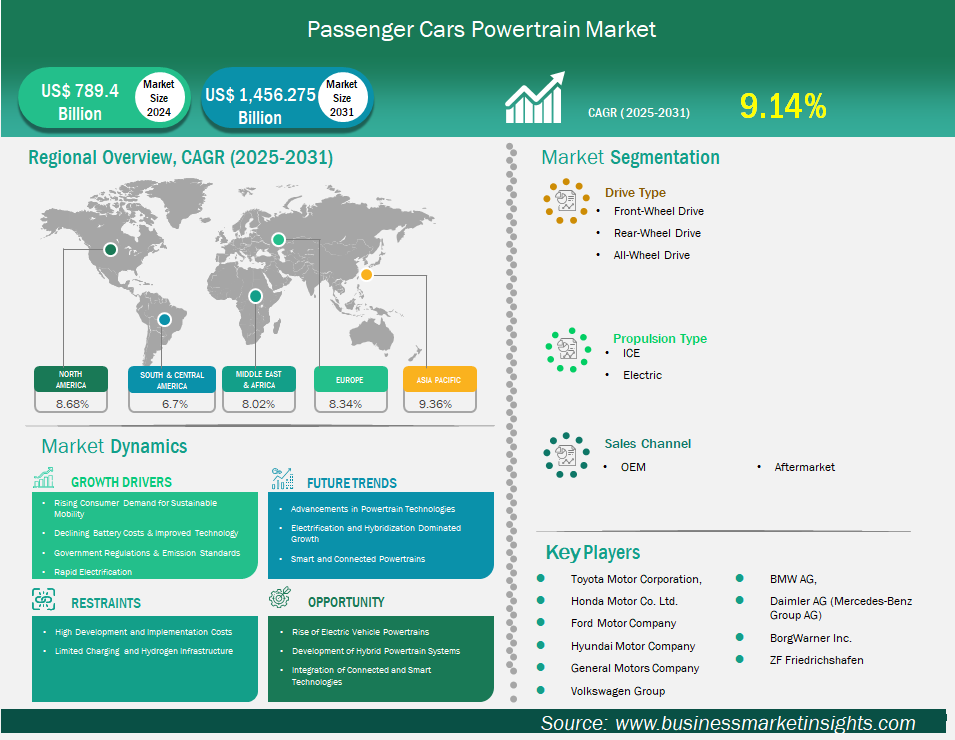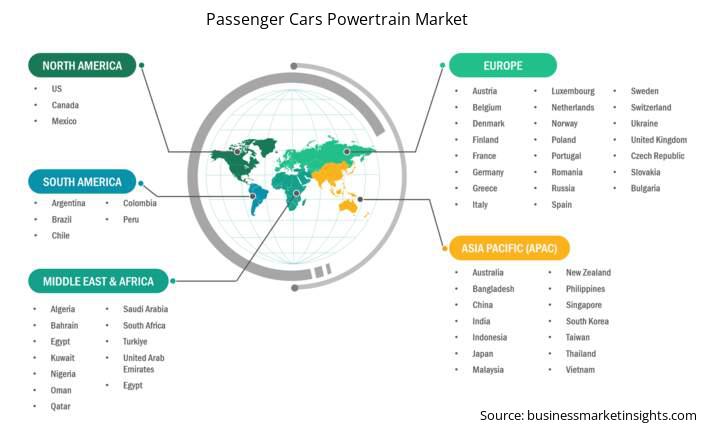Passenger Cars Powertrain Market Outlook (2021-2031)
No. of Pages: 200 | Report Code: BMIPUB00031702 | Category: Automotive and Transportation
No. of Pages: 200 | Report Code: BMIPUB00031702 | Category: Automotive and Transportation
The passenger cars powertrain market size is expected to reach US$ 1,456.27 billion by 2031 from US$ 789.4 billion in 2024. The market is estimated to record a CAGR of 9.14% from 2025 to 2031.
Executive Summary and Global Market Analysis:
The global passenger cars powertrain market is undergoing a radical transformation as automakers accelerate the shift toward electrification, sustainability, and advanced propulsion technologies. As governments worldwide enforce stricter emissions regulations and offer incentives for clean mobility, automakers are investing heavily in the development of electric and hybrid powertrains. This transition is further supported by technological innovations such as high-voltage architectures, advanced battery management systems, and integrated smart technologies that enhance performance, efficiency, and connectivity. While internal combustion engines (ICEs) continue to play a role in certain regions, especially where electric vehicle (EV) infrastructure is still developing, the long-term outlook clearly favors electrified solutions.
Regional dynamics are also significant, with Asia-Pacific—particularly China and India—emerging as major growth markets due to rising urbanization and supportive government policies. Established automotive giants like Toyota, Volkswagen, and Hyundai, alongside specialized powertrain manufacturers such as BorgWarner and ZF Friedrichshafen, are leading the charge in innovation and market expansion. However, the industry faces challenges, including high development costs, the need for robust charging infrastructure, and supply chain complexities. Despite these hurdles, the passenger car powertrain market is poised for robust growth, with electrification, hybridization, and smart technologies at the forefront.

Key segments that contributed to the derivation of the Passenger Cars Powertrain market analysis are drive type, propulsion, sales channel, and geography.
Governments across the globe are implementing increasingly strict regulations on vehicle emissions to combat climate change and improve air quality. These regulations, such as the Euro 7 standards in Europe and Corporate Average Fuel Economy (CAFE) standards in the United States, are compelling automakers to accelerate their transition to electric and hybrid powertrains. Furthermore, many governments offer substantial financial incentives, including tax credits and subsidies, to encourage consumers to purchase electric vehicles, thereby directly stimulating demand for these advanced powertrains.
Continuous innovation in powertrain technology is a primary driver of market growth. Significant improvements in battery energy density, charging speeds, and the efficiency of electric motors are making EVs more practical and appealing to a broader range of consumers. Critically, the cost of lithium-ion battery packs, the single most expensive component in an EV, has been steadily declining. This trend is bringing the upfront cost of EVs closer to that of their ICE counterparts, a key factor in driving mass-market adoption.
By drive type, Front-Wheel Drive (FWD), Rear-Wheel Drive (RWD), and All-Wheel Drive (AWD) – the growth of the passenger car market is closely linked to evolving consumer preferences, vehicle segment trends, and technological advancements. FWD remains the most prevalent drive type globally, especially in hatchbacks, sedans, and compact SUVs. Its popularity is driven by cost-effectiveness, fuel efficiency, and packaging advantages, making it ideal for urban and family-oriented vehicles.
By propulsion type, the passenger car market is experiencing a dynamic shift, with both internal combustion engine (ICE) vehicles and electric vehicles (EVs) showing robust growth, albeit with markedly different trajectories. ICE vehicles continue to dominate global passenger car sales, especially in regions like Asia Pacific, which held the largest market share in 2024 and is projected to maintain strong growth.
By sales channel, the OEM channel, representing factory-fitted components and new vehicle sales, continues to dominate overall market value. Growth in the OEM channel is driven by rising global vehicle production, increasing consumer preference for electric and hybrid vehicles, and the expansion of connected car ecosystems. The passenger cars aftermarket, which includes replacement parts, accessories, maintenance, and upgrades, is also experiencing strong and sustained growth. Key growth drivers include an aging vehicle fleet, increased vehicle longevity, environmental awareness, customization trends, and the transition to electric vehicles.
By geography, the passenger car market is experiencing robust but regionally varied growth, shaped by economic development, urbanization, government policies, and evolving consumer preferences. Asia Pacific is the largest and fastest-growing passenger car market, led by China, India, and Japan. Southeast Asian countries like Indonesia, Vietnam, and the Philippines are also witnessing surges in demand due to rising incomes and urbanization.
Passenger Cars Powertrain Market Report Highlights
Report Attribute
Details
Market size in 2024
US$ 789.4 Billion
Market Size by 2031
US$ 1,456.275 Billion
Global CAGR (2025 - 2031) 9.14%
Historical Data
2021-2023
Forecast period
2025-2031
Segments Covered
By Drive Type
By Propulsion Type
By Sales Channel
Regions and Countries Covered
North America
Europe
Asia-Pacific
South and Central America
Middle East and Africa
Market leaders and key company profiles
The "Passenger Cars Powertrain Market Outlook (2021–2031)" report provides a detailed analysis of the market covering below areas:

The geographical scope of the Passenger Cars Powertrain market report is divided into five regions: North America, Asia Pacific, Europe, Middle East & Africa, and South & Central America. The Passenger Cars Powertrain market in Asia Pacific is expected to grow significantly during the forecast period.
The Asia Pacific Passenger Cars Powertrain market is segmented into China, Japan, South Korea, India, Australia, New Zealand, Indonesia, Malaysia, Philippines, Singapore, Thailand, Vietnam, Taiwan, and Bangladesh. The Asia-Pacific (APAC) region is poised to not only dominate the global passenger car powertrain market in terms of volume but also to witness the highest and fastest growth rate in the coming years. This exceptional growth is a multifaceted phenomenon driven by a powerful combination of government ambition, manufacturing prowess, and burgeoning consumer demand.
The Asia Pacific region experiences substantial growth in its Passenger Cars Powertrain market because of Aggressive Government Policies and Subsidies, Manufacturing and Supply Chain Supremacy, Rising Urbanization and Economic Growth etc.
China continues to be the unparalleled leader. Its market is characterized by hyper-competition among domestic brands (like BYD, Nio, and XPeng) and international giants, leading to rapid innovation and a wide variety of EV models available to consumers.
India represents the next frontier of growth. While currently dominated by ICE vehicles, the passenger EV market is expanding at an explosive rate from a low base, driven by new model launches and growing consumer awareness.
With mature markets such as Japan and South Korea driving the technological innovation through highly efficient hybrid systems and cutting-edge BEV technology. Other ASEAN countries like Thailand, Indonesia, and Vietnam are emerging as the next wave of growth. With government support and investment from major Chinese, Japanese, and Korean automakers, this region is quickly becoming a key battleground for market share in the affordable EV segment.
The Passenger Cars Powertrain market is evaluated by gathering qualitative and quantitative data post primary and secondary research, which includes important corporate publications, association data, and databases. A few of the key developments in the Passenger Cars Powertrain market are:
The Passenger Cars Powertrain Market is valued at US$ 789.4 Billion in 2024, it is projected to reach US$ 1,456.275 Billion by 2031.
As per our report Passenger Cars Powertrain Market, the market size is valued at US$ 789.4 Billion in 2024, projecting it to reach US$ 1,456.275 Billion by 2031. This translates to a CAGR of approximately 9.14% during the forecast period.
The Passenger Cars Powertrain Market report typically cover these key segments-
The historic period, base year, and forecast period can vary slightly depending on the specific market research report. However, for the Passenger Cars Powertrain Market report:
The Passenger Cars Powertrain Market is populated by several key players, each contributing to its growth and innovation. Some of the major players include:
The Passenger Cars Powertrain Market report is valuable for diverse stakeholders, including:
Essentially, anyone involved in or considering involvement in the Passenger Cars Powertrain Market value chain can benefit from the information contained in a comprehensive market report.